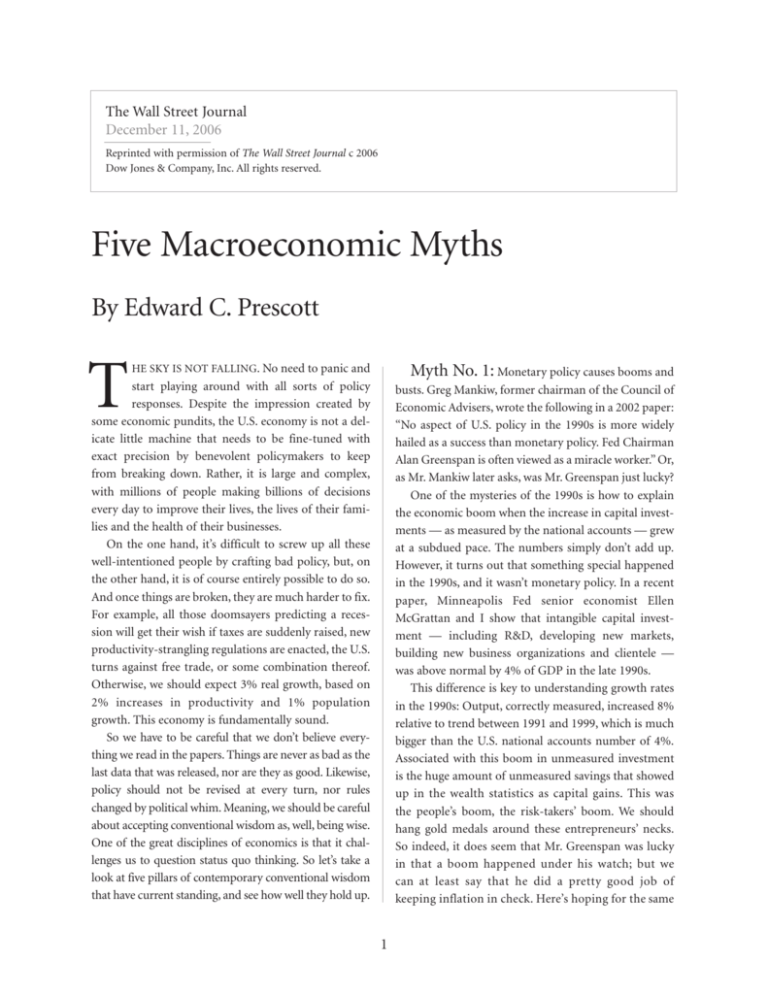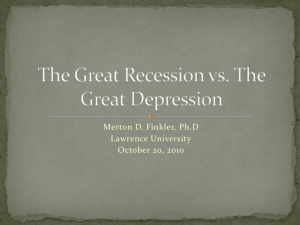
The Wall Street Journal
December 11, 2006
Reprinted with permission of The Wall Street Journal c 2006
Dow Jones & Company, Inc. All rights reserved.
Five Macroeconomic Myths
By Edward C. Prescott
T
Myth No. 1: Monetary policy causes booms and
HE SKY IS NOT FALLING. No need to panic and
start playing around with all sorts of policy
responses. Despite the impression created by
some economic pundits, the U.S. economy is not a delicate little machine that needs to be fine-tuned with
exact precision by benevolent policymakers to keep
from breaking down. Rather, it is large and complex,
with millions of people making billions of decisions
every day to improve their lives, the lives of their families and the health of their businesses.
On the one hand, it’s difficult to screw up all these
well-intentioned people by crafting bad policy, but, on
the other hand, it is of course entirely possible to do so.
And once things are broken, they are much harder to fix.
For example, all those doomsayers predicting a recession will get their wish if taxes are suddenly raised, new
productivity-strangling regulations are enacted, the U.S.
turns against free trade, or some combination thereof.
Otherwise, we should expect 3% real growth, based on
2% increases in productivity and 1% population
growth. This economy is fundamentally sound.
So we have to be careful that we don’t believe everything we read in the papers. Things are never as bad as the
last data that was released, nor are they as good. Likewise,
policy should not be revised at every turn, nor rules
changed by political whim. Meaning, we should be careful
about accepting conventional wisdom as, well, being wise.
One of the great disciplines of economics is that it challenges us to question status quo thinking. So let’s take a
look at five pillars of contemporary conventional wisdom
that have current standing, and see how well they hold up.
busts. Greg Mankiw, former chairman of the Council of
Economic Advisers, wrote the following in a 2002 paper:
“No aspect of U.S. policy in the 1990s is more widely
hailed as a success than monetary policy. Fed Chairman
Alan Greenspan is often viewed as a miracle worker.” Or,
as Mr. Mankiw later asks, was Mr. Greenspan just lucky?
One of the mysteries of the 1990s is how to explain
the economic boom when the increase in capital investments — as measured by the national accounts — grew
at a subdued pace. The numbers simply don’t add up.
However, it turns out that something special happened
in the 1990s, and it wasn’t monetary policy. In a recent
paper, Minneapolis Fed senior economist Ellen
McGrattan and I show that intangible capital investment — including R&D, developing new markets,
building new business organizations and clientele —
was above normal by 4% of GDP in the late 1990s.
This difference is key to understanding growth rates
in the 1990s: Output, correctly measured, increased 8%
relative to trend between 1991 and 1999, which is much
bigger than the U.S. national accounts number of 4%.
Associated with this boom in unmeasured investment
is the huge amount of unmeasured savings that showed
up in the wealth statistics as capital gains. This was
the people’s boom, the risk-takers’ boom. We should
hang gold medals around these entrepreneurs’ necks.
So indeed, it does seem that Mr. Greenspan was lucky
in that a boom happened under his watch; but we
can at least say that he did a pretty good job of
keeping inflation in check. Here’s hoping for the same
1
Five Macroeconomic Myths, By Edward Prescott, The Wall Street Journal, December 11, 2006
performance from our current chairman.
What about busts? Let’s begin with the assumption
that tight monetary policy caused the recession of 19781982. This myth is so firmly entrenched that I could
have called this downturn the “Volcker recession” and
readers would have understood my reference. To accept
the myth, you have to accept a consistent relationship
between monetary policy and economic activity — and
as we’ve just seen, this relationship is simply not evident
in the data.
Between 1975 and 1980, the inflation-corrected federal funds rate was low; at the same time, output trended upward until late 1978. So far, things look somewhat
promising for the mythmakers. But looking closer at the
data we see that output began its downward trend in late
1979 while monetary policy was still easy through most
of 1980. Also, output continued its decline through
1982, when it began to climb at a time when monetary
policy remained tight.
These facts do not square with conventional wisdom.
Our obsession with monetary policy in the conduct of
the real economy is misplaced.
One caveat: I am not saying that there are no real
costs to inflation — there certainly are. And if we get too
much inflation we can exact high costs on an economy
(witness Argentina as an example). However, I am talking here of the vast majority of industrialized countries
who live in a low-inflation regime and who are in no
danger of slipping into hyperinflation. It is simply
impossible to make a grave mistake when we’re talking
about movements of 25 basis points.
the 3.9% growth of the early 1970s and less than the
5.5% growth of the mid-1970s expansion. Even when
we account for unmeasured investment and add four
percentage points, the 1990s growth spurt — fueled by
rapid growth in tech industries — still falls short of the
1980s boom and does not approach the 1960s, both of
which were fueled by tax cuts.
So we have to be careful about mythologizing the
1990s and drawing misguided policy lessons; yes, it was
a boom, and it was better than we think, but let’s keep
that boom in perspective.
Myth No. 3: Americans don’t save. This is a persistent misconception owing to a misunderstanding of
what it means to save. To get a complete picture of savings we need to investigate economic wealth relative to
income. Our traditional measures of savings and investment, the national accounts, do not include savings
associated with tangible investments made by businesses and funded by retained earning, government investments (like roads and schools) and business intangible
investments.
If we want to know how much people are saving, we
need to look at how much wealth they have. People
invest themselves in many and varied ways beyond their
traditional savings accounts. Viewing the full picture —
economic wealth — Americans save as much as they
always have; otherwise, their wealth relative to income
would fall. We’re saving the right amount.
Myth No. 4: The U.S. government debt is big. The
key measure here is privately held interest-bearing federal government debt, which includes debt held by foreign central banks, and does not include debt held by
the Fed or government debt held by the government. So
let’s turn to the historical data once again.
Privately held interest-bearing debt relative to
income peaked during World War II, fell through the
early 1970s, rose again through the early 1990s, and then
fell again until 2003. Even though that number has been
rising in recent years (except for the most recent one), it
is still at levels similar to the early 1960s, and lower than
levels in most of the 1980s and 1990s. This debt level
Myth No. 2: GDP growth was extraordinary in the
1990s. Even though I referred to the expansion of the
’90s as a boom, inasmuch as it was a period of abovetrend growth, and I noted the strong gains due to
unmeasured investment, we have to put things into historical context. So let’s return to the data. GDP growth
relative to trend in the early 1960s was 12%, and in the
famous 1980s boom (from the end of 1982 to mid1989) it was a very impressive 9.7%.
And how about the boom from the previous decade?
From 1996 to 1999, GDP grew 3.8%, about in line with
2
Five Macroeconomic Myths, By Edward Prescott, The Wall Street Journal, December 11, 2006
There are at least three lessons here. First: Context
was not alarming then, and it is not alarming now. From
a historical perspective, the current U.S. government
debt is not large.
matters. Take what you read in the paper with a many
grains of historical salt. Second: Current data often provide poor guidance for effective policy making. To make
forward-looking policies you have to understand the
past. Finally: Establish good rules, change them infrequently and judiciously, and turn the people loose upon
the economy. Booms will follow. n
Myth No. 5: Government debt is a burden on our
grandchildren. There’s no better way to get people
worked up about something than to call on their sympathies for their beloved grandkids. The last thing that I
want to do is to burden my own grandchildren with the
sins of profligacy. But we should stop feeling guilty — at
least about government debt — because we are in better
shape than conventional wisdom suggests.
Theory and practice tell us that the optimal amount
of public debt that maximizes the welfare of new generations of entrants into the workforce is two times gross
national income, or GDP. This assumes 1% population
growth, 2% productivity growth, 4% real after-tax
return on investments, and that people work to age 63
and live to age 85. Currently, privately held public debt
is about 0.3 times GDP, and if we include our Social
Security obligations, it is 1.6 times GDP. In either case,
we could argue that we have too little debt.
What’s going on here? There are not enough productive assets — tangible and intangible assets alike — to
meet the investment needs of our forthcoming retirees.
The problem is that the rate of return on investment —
creating more productive assets — decreases as the stock
of these assets increases. An excessive stock of these productive assets leads to inefficiencies.
Total savings by everyone is equal to the sum of productive assets and government debt, and if there is an
imbalance in this equation it does not mean we have too
little or too many productive assets. The fix comes from
getting the proper amount of government debt. When
people did not enjoy long retirements and population
growth was rapid, the optimal amount of government
debt was zero. However, the world has changed, and we
in fact require some government debt if we care about
our grandchildren and their grandchildren.
If we should worry about our grandchildren, we
shouldn’t about the amount of debt we are leaving them.
We may even have to increase that debt a bit to ensure
that we are adequately prepared for our own retirements.
Mr. Prescott is senior monetary adviser at the Federal
Reserve Bank of Minneapolis and professor of economics at
the W.P. Carey School of Business at Arizona State University.
He is a co-recipient of the 2004 Nobel Prize in economics.
(See related letter: “Letters to the Editor: Beware Economic
Stresses Just Over Horizon” — WSJ Dec. 22, 2006)
3








